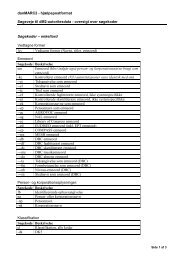RFID Data Model for Libraries - biblstandard
RFID Data Model for Libraries - biblstandard
RFID Data Model for Libraries - biblstandard
Create successful ePaper yourself
Turn your PDF publications into a flip-book with our unique Google optimized e-Paper software.
<strong>RFID</strong> <strong>Data</strong> model <strong>for</strong> libraries Doc 067<br />
Thereby the usefulness of the data model will be expanded beyond the basic part of the Latin<br />
alphabet.<br />
Format in<strong>for</strong>mation<br />
Some types of <strong>for</strong>mat in<strong>for</strong>mation will be needed. The data model is separated in different<br />
blocks. There will be starting and ending in<strong>for</strong>mation.<br />
There will also be the need <strong>for</strong> <strong>for</strong>mat check by check calculating algorithms. These shall be<br />
identified as well. The data model is open <strong>for</strong> extensions <strong>for</strong> several fields <strong>for</strong> content larger<br />
than the specified length. Here a certain <strong>for</strong>mat signal will indicate the handling of overflow.<br />
2.5 Physical mapping<br />
The working group has introduced the category ‘Physical mapping’. Again the complexity of<br />
the <strong>RFID</strong> tag shows that the physical mapping and variation hereof can influence the<br />
efficiency in reading from a particular data model including its encoding.<br />
Through the cooperation of three of the companies participating the working group has had a<br />
series of empirical tests made. The results of these tests have <strong>for</strong>med a solid suggestion <strong>for</strong> the<br />
physical mapping. The findings of these tests can be seen in Annex B: Empirical test results.<br />
Inventory Operation Per<strong>for</strong>mances versus Read Memory Size.<br />
It can be observed that the technology is perfecting more and more but that areas are still to be<br />
improved. There<strong>for</strong>e optimisation by the physical mapping of the tag is a method that will<br />
speed up operation and raise accuracy and is an issue worth while pursuing. This is reflected<br />
in the lay out of the data model.<br />
2.6 Pre-requisites<br />
2.6.1 Background standards<br />
The data model <strong>for</strong> <strong>RFID</strong> applications in libraries is based on a number of international<br />
standards.<br />
The working group had no doubts that concerning air interface the data model should rely on<br />
the ISO/IEC 18000 family of standards. Of this ISO/IEC18000-3 is selected as it specifies the<br />
appropriate choice of frequency: 13.56 MHz. See Annex A: Selection of <strong>RFID</strong> carrier<br />
frequency <strong>for</strong> library applications.<br />
ISO/IEC 15961: <strong>Data</strong> protocol: application interface, ISO/IEC 15962 <strong>Data</strong> protocol: data<br />
encoding rules and logical memory functions and ISO/IEC 15963 Unique identification <strong>for</strong><br />
<strong>RFID</strong> tags shall <strong>for</strong>m the basis <strong>for</strong> the next step in the <strong>RFID</strong> library applications.<br />
ISO 15511:2003 International Standard Identifier <strong>for</strong> <strong>Libraries</strong> and Related Organizations<br />
(ISIL) is selected <strong>for</strong> identifying libraries using <strong>RFID</strong> applications according to this data<br />
model.<br />
19




